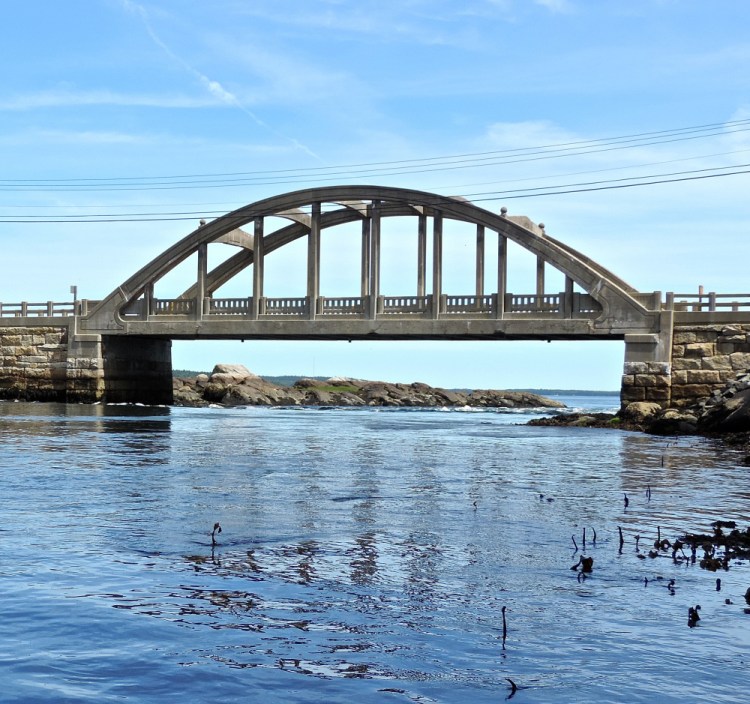If you want a beautiful place to paddle where you can have fun yourself while also watching other do the same, Salt Pond in Blue Hill is the place.
This tidal, saltwater pond is a very entertaining place on the incoming tide when a powerful flow of water under the Route 175 bridge fills Salt Pond. The faucet is wide open, and paddlers near and far converge at the small cove west of the bridge to test and hone their whitewater skills at Blue Hill Falls.
Most stay upright, some do not.
Consult the DeLorme Maine Atlas and Gazetteer (map No. 15) for help in getting to Salt Pond, about an hour from Bangor to the coast and less than two hours from Augusta. We parked at the very northern end of the pond where there is room enough to pull off the road on the right, a few hundred yards north of the Route 175 bridge. The small tidal lagoon here leads down to the larger Salt Pond. We were there near low tide and had to lift our canoe up and over an exposed line of rocks connecting the shorelines a quarter-mile south of the put-in site.
Salt Pond is four miles in length and can be paddled end to end by canoe or kayak at mid to high water. Depending on the time of the tide, there may be currents and eddies at the narrower portions of the pond, so paddlers will want to be experienced in moving water situations.
We saw many blue herons, kingfishers and loons congregated around the narrows a half-mile south of the bridge. The upswelling of water provides a smorgasbord of food options. South of the narrows, you will come upon a mussel growing operation in the middle of a large bay. Round buoys – black, white and yellow – stretched in all directions. We stopped to chat with an engaging fellow along the shoreline working at his wharf, and he filled us in on his harvesting operation and what was happening with the buoys we had just paddled through.
There are a few homes scattered in the hillside forests along the shoreline, but for the most part the pond is undeveloped, with evergreen and oak lining the shoreline. Halfway down the pond, a large open slope of glacial boulders dots the landscape of a patch of commercial blueberry fields on Route 172. We pulled our canoe onto a ledge and carefully wove our way up to the edge of the field to take pictures of a striking boulder near the crest of the hill. It looked like a massive head of Snoopy. Smaller boulders burst up out of the deep green blueberry leaves, akin to someone taking a full handful of peanuts and scattering them across your living room rug.

A kayaker, equipped with a personal flotation device, plays in the tidal surge near the bridge on Route 175 in Blue Hill.
We concluded our three hours of poking about with another stop along the shoreline to watch paddlers match their skills against the frothing stream of water channeling into the pond from Blue Hill Bay. A large crowd had gathered near the bridge to watch the action. We were pleased to see that everyone took water safety seriously. All swimmers and boaters wore personal flotation devices and were careful to look out for each other as they took turns churning down through the rapids.
Shouts of encouragement from the shoreline and whoops of joy and exhilaration coming from the rapids created a festive atmosphere. The back eddy created by the incoming tide makes it easy to get close enough to see the action without having to get out into the powerful flow of water in the middle of the cove.

In the blueberry fields that look down toward Salt Pond, plenty of rocks poke through the earth.
As we glided into the peaceful lagoon leading back to the put-in site, five yellowlegs watched us pass from their crowded perch on a small flat rock. Once we got the canoe secured on our car rack, we crossed the road for a refreshing swim in Blue Hill Bay.
We made sure to leave a few extra hours to drive around the Blue Hill-Brooklin area, creating a scenic loop out of Routes 175 and 172. A sign at the Brooklin town line proudly states, “The Boat Building Capital of the World.” The tip of Naskeag Point marks the eastern end of Eggemoggin Reach and offers a breathtaking view in all directions. The serene campus of the Wooden Boat School looks out over the reach nearby. The classic cottages of the iconic Haven colony in Brooklin still exist. In one of those cottages, Grand Canyon explorer John Wesley Powell summered for many years.
Michael Perry is the former director of the L.L. Bean Outdoor Discovery Schools, and founder of Dreams Unlimited, specializing in inspiring outdoor slide programs for civic groups, businesses, and schools. Contact:
michaelj_perry@comcast.net
Send questions/comments to the editors.


